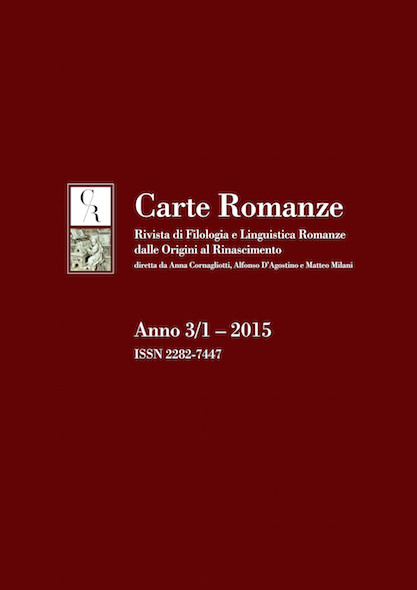Virgil re-purposed in the Old French «Roman d’Eneas»
Contenuto principale dell'articolo
Abstract
In these pages, I deal with three “sticky bits” in the twelfth-century Roman d’Eneas (vv. 483-496, 534-539, and 9792-9814). These are vernacular “marvels” that have stumped concerned philologists for at least one hundred years (beginning with Edmond Faral, 1913). The first segment deals with the crocodiles found in the waters of “Libya” (i.e., Dido’s Carthage); mysteriously, they have no bowels. Next, the Capitol building in Carthage possesses special acoustics, we are told, that make distant whispers audible. Finally, Pallas’ baldric (ripped off by Turnus once he slays the youth) is changed by the anonymous Old French poet to a finger ring. I attempt to offer suggested explanations for the three non-Virgilian embellishments.
In questo contributo mi occupo di tre “divagazioni” che l’autore del Roman d’Eneas compie rispetto alla fonte latina (vv. 483-496, 534- 539 e 9792-9814), tre elementi del “meraviglioso” che hanno disorientato, per un centinaio d’anni (a partire da Edmond Faral, nel 1913) i filologi che se ne sono occupati. Il primo segmento tratta dei coccodrilli trovati nelle acque della “Libia” (ovvero, la Cartagine di Didone): misteriosamente, essi sono privi di viscere. Nel segmento successivo è descritto il Campidoglio di Cartagine, la cui speciale acustica consente – cosí ci dice l’autore – di ascoltare i sospiri anche a distanza. Infine, il bàlteo di Pallante (sottratto da Turno nel momento in cui egli uccide il giovane) è sostituito dall’anonimo poeta antico-francese con un anello. Per ciascuno di questi abbellimenti non virgiliani, tento di offrire una spiegazione convincente.
Dettagli dell'articolo
Carte Romanze si serve di una licenza  Creative Commons. Attraverso la licenza CC-BY-NC-ND gli autori conservano tutti i diritti economici e concedono alla rivista il diritto non esclusivo di pubblicazione, permettendo a chiunque di scaricare il contributo, di leggerlo e stamparlo. Ogni riuso deve prevedere la citazione virgolettata (o comunque riconoscibile), garantendo all’autore la proprietà intellettuale di quanto citato, e segnalando sempre e comunque la rivista come fonte (con l’indicazione dell’annata, del volume e delle pagine). Non è invece concessa a nessuno la modifica del contributo né il riuso per creare opere secondarie.
Creative Commons. Attraverso la licenza CC-BY-NC-ND gli autori conservano tutti i diritti economici e concedono alla rivista il diritto non esclusivo di pubblicazione, permettendo a chiunque di scaricare il contributo, di leggerlo e stamparlo. Ogni riuso deve prevedere la citazione virgolettata (o comunque riconoscibile), garantendo all’autore la proprietà intellettuale di quanto citato, e segnalando sempre e comunque la rivista come fonte (con l’indicazione dell’annata, del volume e delle pagine). Non è invece concessa a nessuno la modifica del contributo né il riuso per creare opere secondarie.
Quando siano rispettate le indicazioni di cui sopra, non è necessario richiedere ulteriori permessi di utilizzazione del materiale né all’autore né al comitato scientifico.

